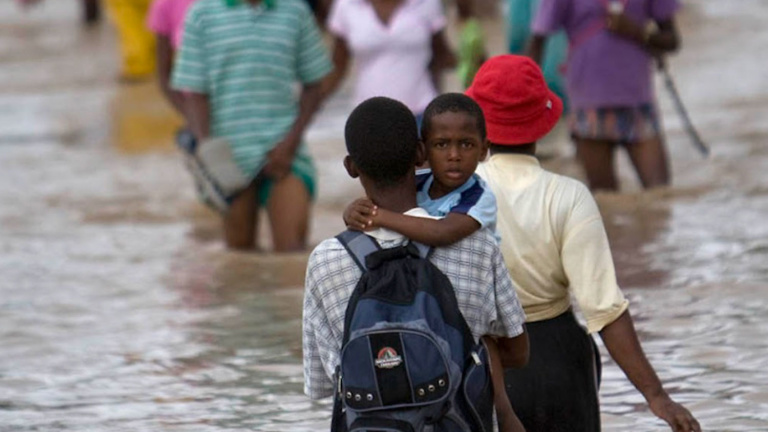
The when and how of climate conflict: The case of Mali
Climate change itself is not a direct cause of violent conflict. Yet, extreme changes in climate increase the risk of conflict by exacerbating people’s existing political, economic and social vulnerabilities.
Under what circumstances a risk factor?
Studies looking at the relationship between climate and conflict have produced diverse and contested results. Today, most experts acknowledge that climate change acts as a “threat multiplier”. While most earlier research focused on the statistical relationship between conflict dynamics and historical patterns of climate change, studies now recognise and incorporate societal factors into the equation, looking at both qualitative and quantitative variables.
The question is no longer whether climate change is a direct cause of conflict, but rather, under what circumstances is climate change a risk factor for violent conflict?
“Ground zero” of climate change
The risk of conflict is highly context-dependent. Certain regions are especially vulnerable to extreme weather. Dubbed the “ground zero” of climate change, the Sahel is one of these regions. The European Union and UN Security Council have both recognised climate change as a significant factor in propelling conflict and security dynamics across the Sahel. Despite it being one of Africa’s most productive crop zones, extreme and rapid changes in rainfall and temperature have hindered agricultural production here, worsening communities’ insecurities and weakening social relations.
This has made Mali a hot spot for discussions on the climate–security nexus. The country is particularly vulnerable to climate change due to its slow economic development, limited suitable land for agriculture and rapid population growth. Mali also embodies certain factors that are especially influential in determining conflict risk, such as weak capacity of the state, intergroup inequality and a recent history of violent conflict.
Security dynamics in Mali gained widespread international attention after the coup d’état in 2012. However, climate-induced violence has been part of the country’s social structure for many decades.
An important step towards understanding the role of climate in these conflict dynamics is to look at the implications of climate change at the subnational level. In Mali, climate-related conflicts have often taken the form of communal conflicts, involving groups identified along ethnic, linguistic and religious lines. This can imply other common identities, based on history, culture, livelihood and core values.
Particularly in Africa, ethnicity and livelihoods are closely interlinked. Many communal conflicts in Mali centre on access to land. Different land users, such as farmers and herders, often belong to specific ethnic groups, such as the Dogon and Fulani, respectively. Thus, clashes between different occupational segments of society frequently have livelihood and ethnic dimensions.
The 23 March 2019 massacre was Mali’s latest and deadliest incident. Some 160 civilians, mostly semi-nomadic Fulani herders, were killed in the villages of Ogossagou and Welingara in the Mopti region, allegedly by Dogon farmers (see Map 2). The international community looked first to radicalisation and ethnic divisions to explain the attack. But climate change has since been recognised as creating fertile grounds for the conflict to erupt.
Map 1: Mali’s administrative divisions and the informal demarcation of its ‘north’

Source: https://www.clingendael.org/pub/2015/beyond_dichotomy/1_understanding_the_politics/
A continuous cycle of droughts and floods has had detrimental impacts on Malians. Since the 1960s, rainfall has diminished by 30%, destroying more than a third of livestock and leading to widespread food shortages. This, combined with a mean annual temperature increase of 0.8°C, has accelerated deforestation and put further pressure on land. Declining resource availability threatens both food security and livelihood security. If not addressed, the predicted losses in livelihoods could mean an overall loss of welfare ranging from US $70 to $142 million. That would increase those at risk of hunger from 44% to over 70% of the population.
Different adaptation strategies have changed the traditional routines of farmers and herders in the country, increasing the frequency of inter-group conflict in certain areas. Changes in the environment and reduced resources has forced herders to change their migration paths, closer towards the near-permanent water resources in the south and central regions. Some have now settled in locations where they traditionally spent only short periods of time.
Routes that have existed for hundreds of years are now disappearing. Herders see their loss as more than just a loss of passage, but also as a forfeiture of part of their identity. At the same time, agricultural lands have expanded substantially over the past 40 years, as the government has sought to increase agricultural production. While this has helped farmers sustain their livelihoods, it has taken away lands that were once used by herders.
Map 2: An overview of the diversity of Mali’s different ethnic groups

OECD, An Atlas of the Sahara-Sahel, Paris, Sahel and West Africa Club, 2015
Mali’s structural inequalities: The bigger picture
Although Mali is highly vulnerable to the shocks and stresses of climate change, these vulnerabilities are not equally distributed. The minority herder groups, such as Tuaregs, Fulas and Arab Berbers, are more vulnerable than the majority agricultural ethnic populations. Structural inequalities that have existed since colonial times have elicited continuous tension between the two groups. However, extreme changes in the climate have worsened these dynamics, playing a role in outbreaks of violence.
Inequalities have increased the exposure of herder groups to climate hazards, while reducing their ability to cope with and recover from the effects of climate change. They have also aggravated long-held grievances and deteriorated relationships between the two livelihood groups.
Both the French and post-colonial governments favoured farmer groups’ access to land. They mistrusted the “primitive” nomadic communities, considering them “the other”, inhabitants of the wilderness, not belonging to civilisation. Various government reforms have attempted to “sedentarise” the herder groups, as their lifestyles were portrayed as obstacles to progress, urbanisation and modernisation, as well as incompatible with the idea of a strong developed nation.
Despite the historical evidence that mobile livestock systems in the Sahel have high adaptive capacity and ecological efficiency, land tenure reforms have emphasised agricultural expansion. As a result of the shift from mobility to sedentism, many herder communities have been pushed to marginal regions, and their capacity to cope with the changing environment has been significantly reduced.
Moreover, since the colonial era, institutional and customary practices of land tenure have been considerably transformed. Historically, local communities oversaw natural resources management and dispute settlement. The introduction of new political systems, property rights and land tenures brought situations of legal pluralism. The legal framework that was adopted during the decentralisation process in the 1990s resulted in both competition and overlap between legal and customary institutions. The lack of a comprehensive and unified legal framework has triggered intra- and inter-communal tension, as most development programmes have given priority to agriculture-oriented policies. This has left herders without legal recourse to seek compensation for the disappearance of their grazing lands. While climate change is disrupting the physical availability of natural resources, these developments have erected social boundaries that determine who can access what, when and how.
The preference for agricultural development has also created a power imbalance. More farmers are being incorporated into the political system, while herder groups’ access to and control of land for production is decreasing. This, combined with rapid growth of the agricultural, commercial and industrial sectors, has generated greater competition and conflict over basic natural resources. As a result, herders increasingly perceive themselves as “victims” and see taking up modern weapons as the way to challenge existing hierarchies, as well as to contest the privileges of urban elites and traditional local aristocracies.
Moving forward
Measures for climate change adaptation cannot be developed without understanding the local context – in this case, the structural inequalities within Malian society. All proposed measures need to be sensitive to the contextual factors unique to socio-ecological systems. Mali provides a clear example of the role that climatic shocks and stresses can play in outbreaks of violent conflict, by worsening long-existing social, political and economic grievances and tensions between different communal groups.
The task to build resilience to the impacts of climate change offers a unique opportunity to tackle the institutional deficits that perpetuate vulnerabilities. By recognising the herder population as a valuable part of society, and their lifestyle as a form of proactive adaptation, grievances shared by these groups could be reduced. Increasing political representation of herders, as well as establishing a unified legal framework for natural resources management, would also pave the way for a more harmonious society in which all voices are heard.
In this regard, some progress has been made. Both national governments and the international community have begun to recognise the security risks posed by climate change and resource pressures. However, issues of access to resources and the multiple dimensions of inequality that encompass ethnicity, gender, age, race, religion and culture have still not been fully addressed.
We need stronger political commitment and concrete strategies in developing adaptation measures. Only then can the international community prevent clashes from erupting into full-blown conflict – in Mali, and in the rest of the Sahel.
About the author
Basak Kalkavan is a Tutor for the BSc. Security Studies program at the Institute of Security at the Institute of Security and Global Affairs of Leiden University. She has a BA in international studies with a specialisation in international security and conflict resolution from Simon Fraser University in Vancouver, Canada, and an MSc in international relations and diplomacy from Leiden University. Her research interests are climate security, conflict resolution and environmental peacebuilding. b.kalkava@fgga.leidenuniv.nl Twitter: @bsk_klkvn
LinkedIn: @basakkalkavan
Read the full magazine issue









